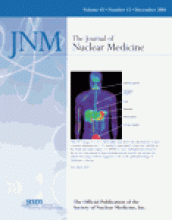TO THE EDITOR:
With interest I read the letter of Britton concerning radioimmunotherapy (RIT) of non-Hodgkin’s lymphoma (NHL) (1). In brief, he compares RIT of NHL with other therapies using radionuclides, in which a tracer dose of a radiopharmaceutical is given and imaging is performed before the actual treatment. This procedure allows selection of patients based on assessment of uptake of the radiopharmaceutical, and it allows (tumor) dosimetry. Britton notices that neither procedure is advocated when planning RIT using 90Y-ibritumomab. He therefore raises the question of whether we should uphold our own nuclear medicine approach to selecting patients and dosing the radiopharmaceutical.
In NHL patients, the maximum tolerated dose of radiolabeled monoclonal antibodies (mAbs) is limited by the absorbed dose that the bone marrow can tolerate or by second-organ toxicity in myeloablative RIT (2). Every radiopharmaceutical for RIT of NHL patients has its own dosing scheme, based on body weight, bone marrow dosimetry, or body surface area (2). So far, no nonmyeloablative dosing method has been proven to be superior or to lead to higher response rates than others. None of the dosing methods use tumor dosimetry to determine the dose to be administered to the patient. One reason is that the myelotoxicity of the radiopharmaceutical will limit further increments of radioactivity doses, and not the absorbed dose to the tumor, but there are 2 more reasons.
First, in not all patients can lymphoma sites clearly be seen on scintigraphy after a tracer dose of radiolabeled mAbs. This does not mean that a patient cannot benefit from RIT, as Britton postulates (1). In my patient experiencing a complete response after RIT, no uptake of 99mTc-epratuzumab was observed in known lymphoma sites on scintigraphy (3). Still, this patient was selected for treatment because of positive CD22 antigen expression on histologic material from his lymphoma. Even on scintigraphy after treatment with 186Re-epratuzumab, the lymphoma could not be detected, but a complete response was observed (3). Scintigraphy, however, can be used to exclude patients from further treatment: not because visual assessment of scintigraphy does not show lymphoma uptake but because the radiopharmaceutical has an unfavorable biodistribution. If uptake of the radiopharmaceutical is observed only in the bone marrow, it may be wise not to treat the patient because of the severe myelotoxicity or even myeloablation that may result (3).
Second, tumor dosimetry is not used for dosing radiolabeled mAbs since doing so would suggest that a clear dose–response relationship exists and that we know which absorbed dose is minimally needed to induce a response. Neither the former nor the latter holds true. A wide variety of tumor doses was reported, ranging from 0.6 to 243 Gy in cases of treatment with 90Y-ibritumomab (4) and from 0.4 to 18 Gy after treatment with 131I-tositumomab (5), but no correlation was found between doses and response to treatment (5,6). Because the mAbs themselves can induce responses, even absorbed doses as low as 4 Gy are associated with responses to treatment (7). Therefore, tumor dosimetry is of limited value in planning RIT of patients with NHL.
Taking into account the fact that RIT consists of a combination of treatment with mAbs and radionuclide therapy, I do not see a dilemma with respect to the approach to be followed. There is neither an exclusively nuclear medicine approach nor a strictly oncologic approach: RIT is a multidisciplinary treatment modality, using doses of radiolabeled antibodies and radionuclides as determined by safe and sound clinical trials. It is time for nuclear medicine physicians and oncologists to implement this new treatment in routine clinical practice.
REFERENCES
REPLY:
In response to the letter by Dr. Postema, I reiterate my concern that radionuclide β-therapy is not being assessed by prior radionuclide γ-imaging. He cites a case in which a patient responded although the results of prior imaging and posttherapy dose imaging were negative. Surely Dr. Postema does not think that the patient’s response was due to radiation. The logical procedure when pretherapy imaging results are negative in a patient with a disease with a high degree of antigen expression would be to give unlabeled antibody therapy. Whether by antibody-dependent cellular cytotoxicity, ADCC, complement-dependent cytotoxicity, CDC, or human idiotype 2 formation, unlabeled antibody therapy may be effective in up to half of non-Hodgkin’s lymphoma patients, as is stated in his own review (1). Clinical and legal justification of radionuclide therapy requires evidence of uptake of the proposed radionuclide therapy agent, and he should be in a position to make his multidisciplinary team aware of this to avoid unjustified radiation, isolation, or expense in the treatment of a patient with non-Hodgkin’s lymphoma.
Oncologists are trying to individualize their therapy through determining a range of genetic markers for each patient. We in nuclear medicine are able to individualize treatment by prior imaging as proof of uptake. Positive imaging does not “suggest that a clear dose–response relationship exists.” It is just common sense that no uptake predicts no therapeutic effect due to radiation. It does not exclude other beneficial actions of the antibody. The relationship between tumor dose and response in radioimmunotherapy may thus be explained. When the carrier is relatively inert, such as with 131I MIBG, a more direct dose–response relationship is evident. It is our duty to protect patients from unnecessary therapeutic radiation, just as it is our duty to point out the safety of our diagnostic studies in adults. These are basic principles resulting from the “J”-shaped response to radiation (2).







